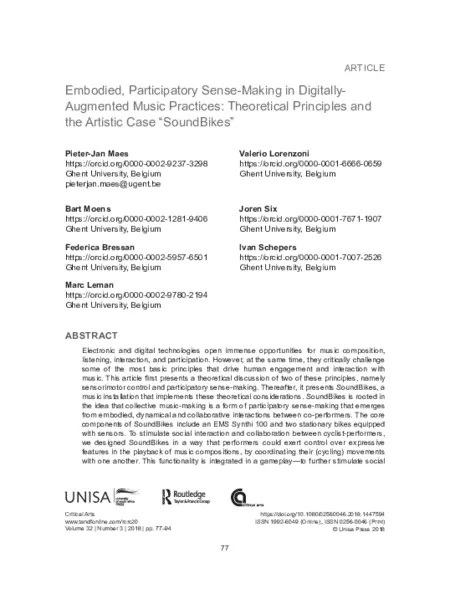Author version | Version of record
Publication type: Journal Articles
Abstract: Electronic and digital technologies open immense opportunities for music composition, listening, interaction, and participation. However, at the same time, they critically challenge some of the most basic principles that drive human engagement and interaction with music. This article first presents a theoretical discussion of two of these principles, namely sensorimotor control and participatory sense-making. Thereafter, it presents SoundBikes, a music installation that implements these theoretical considerations. SoundBikes is rooted in the idea that collective music-making is a form of participatory sense-making that emerges from embodied, dynamical and collaborative interactions between co-performers. The core components of SoundBikes include an EMS Synthi 100 and two stationary bikes equipped with sensors. To stimulate social interaction and collaboration between cyclist-performers, we designed SoundBikes in a way that performers could exert control over expressive features in the playback of music compositions, by coordinating their (cycling) movements with one another. This functionality is integrated in a gameplay—to further stimulate social collaboration and competition—and a visually attractive environment—to provide visual feedback and to create ambiance.
Cite this article:
@article{doi:10.1080/02560046.2018.1447594,
author = {Pieter-Jan Maes and Valerio Lorenzoni and Bart Moens
and Joren Six and Federica Bressan and Ivan Schepers and Marc Leman},
title = {Embodied, Participatory Sense-Making in
Digitally-Augmented Music Practices: Theoretical
Principles and the Artistic Case “SoundBikes”},
journal = {Critical Arts},
volume = {32},
number = {3},
pages = {77-94},
year = {2018},
publisher = {Routledge},
doi = {10.1080/02560046.2018.1447594},
URL = {https://doi.org/10.1080/02560046.2018.1447594}
}

